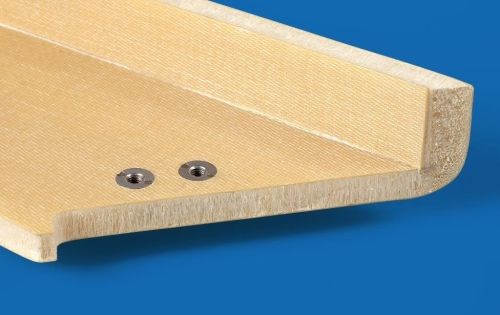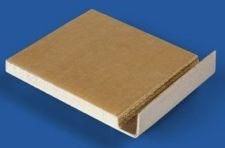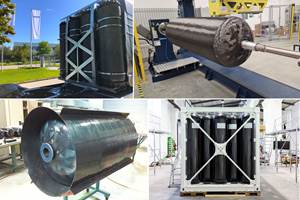Move over honeycomb, thermoplastic sandwich is commercialized as DYNATECH
PEI foam core/skin sandwich panels claim to save up to 40 percent weight and 30 percent cost in rail and aircraft interiors vs. honeycomb.

SMTC has launched DYNATECH thermoplastic sandwich panels for transportation interiors based on FITS technology. SOURCE: SMTC
Honeycomb-cored sandwich panels have been used in aircraft interiors since the 1970s. Passenger rail is more conservative and cost-sensitive, but in Europe, aluminum-cored composite panels have become fairly common. Fiberglass-faced (aircraft and rail) or metal-faced (rail) honeycomb is used in baggage bins (stowbins), lavatories, galleys, tables, trays, partitions, doors and trolley carts. Compression molded cored panels are also used in shaped sidewall and overhead panels. Sara Black’s 2006 CT article, “Advanced materials for aircraft interiors” is a good primer on standard materials and processes used.
A new material has been launched for this market by SMTC (Bouffere, France), a manufacturer of transportation interiors using composite panels since 1983. The company announced at JEC Europe 2014 its launch of DYNATECH thermoplastic sandwich panels, based on its acquisition of Foamed In-situ Thermoformable Sandwich technology from (Driebergen, The Netherlands) inventor and CEO, Martin de Groot (see my article “Thermoformable Composite Panels, Part II” in CT June 2006).

FITS technology was developed to reduce weight and cost in aircraft and other transport interiors. SOURCE: Fits Technology
DYNATECH encompasses an automated panel-making process that enables polyetherimide (PEI) to be in-situ foamed as a core (with a vertical cell structure) and then receive fiber-reinforced PEI skins that are “welded” onto the core inline, as both are thermoplastic. This thermoplastic panel stock is then easily thermoformed into shapes and angles, edges are easily sealed and inserts do not require potting. FITS inventor de Groot asserts that 25 percent of a Nomex honeycomb panel’s weight comes from potting, exterior decorative layers (e.g., Declar) and connections.


DYNATECH panels reportedly offer weight and labor savings via automated processes for thermoformed edges and fastener installation. SOURCE: FITS Technology
The concept of a lightweight cored panel made using a belt press and reinforced thermoplastic faceskins was patented by DuPont in 1990 based on its polyetherketoneketone (PEKK) polymer. CW reported on ’s use of carbon fiber/PEI skins on Nomex honeycomb for the G650 load floors (see “Thermoplastic composites: Inside story”, in HPC Feb 2009). And SABIC (Pittsfield, Mass., USA) has been marketing its Ultem PEI foam for applications like aircraft baggage bins since 2008.
What makes DYNATECH different is that all of the pieces have been put together, including core, skins, thermoforming shapes, edge-finishing, insert installation and now automated panel manufacturing through SMTC’s commercialization of the product. Also, SMTC is an established supplier of interiors, with customers like Bombardier, Alstom, Sogerma and Zodiac Aerospace. Hence, it knows the cost and performance targets and already has supplier relationships in place. Interestingly, a representative from interiors giant Zodiac Aerospace was at the JEC Europe 2014 press conference, and SMTC said it has already discussed qualification with several OEMs.
I’ve asked de Groot for test data showing the reported acoustic and thermal insulation benefits of DYNATECH vs. honeycomb-cored panels, and also for the calculations used to assert the 20 to 40 percent weight savings and 10 to 30 percent cost savings possible. The PEI foam core is higher in density than Nomex honeycomb, but SMTC and de Groot are claiming the structures can be made much thinner. That alone is intriguing as airlines and OEMs look for more interior space.
Also, the big topic at Airbus and Boeing now is “multifunctional,” where interior structure is integrated with other functions such as ventilation, lighting, electrical power, etc., into walls, ceilings and bins. It might be possible to embed a variety of structural components and/or functional elements (e.g., fiber optics) within DYNATECH's core. De Groot also claims that unique design advantages can be exploited — for example, a box-type reinforcement achieved from folding and thermoforming skins up around the panel edges and welded or thermoformed local reinforcements.
The FITS Technology website features a page of demonstrating the concepts for automated edge finishing and insert installation. Illustrations for corner and edge reinforcements are also shown.
SMTC says pilot production will begin this summer with high-volume production slated for 2016.
Related Content
Composites end markets: Pressure vessels (2024)
The market for pressure vessels used to store zero-emission fuels is rapidly growing, with ongoing developments and commercialization of Type 3, 4 and 5 tanks.
Read MorePrepreg compression molding supports higher-rate propeller manufacturing
To meet increasing UAV market demands, Mejzlik Propellers has added a higher-rate compression molding line to its custom CFRP propeller capabilities.
Read MoreLilium launches M&A process, targets eVTOL program continuation
Despite court-approved insolvency filings and beginning first investor briefings, Lilium remains fully focused on re-emerging following restructuring, setting its sights on fresh investment to support the Lilium Jet.
Read MoreECOHYDRO project to enable recyclable composites for hydrogen storage
With the involvement of two schools from the Institut Mines-Télécom, the 4-year project aims to improve the intrinsic properties of a composite material based on Elium via four concrete demonstrators.
Read MoreRead Next
Next-gen fan blades: Hybrid twin RTM, printed sensors, laser shock disassembly
MORPHO project demonstrates blade with 20% faster RTM cure cycle, uses AI-based monitoring for improved maintenance/life cycle management and proves laser shock disassembly for recycling.
Read MoreScaling up, optimizing the flax fiber composite camper
Greenlander’s Sherpa RV cab, which is largely constructed from flax fiber/bio-epoxy sandwich panels, nears commercial production readiness and next-generation scale-up.
Read MoreUltrasonic welding for in-space manufacturing of CFRTP
Agile Ultrasonics and NASA trial robotic-compatible carbon fiber-reinforced thermoplastic ultrasonic welding technology for space structures.
Read More












